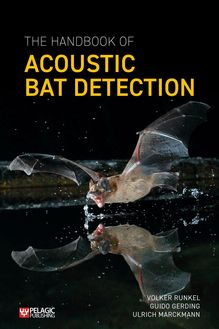-
 Univers
Univers
-
 Ebooks
Ebooks
-
 Livres audio
Livres audio
-
 Presse
Presse
-
 Podcasts
Podcasts
-
 BD
BD
-
 Documents
Documents
-
- Cours
- Révisions
- Ressources pédagogiques
- Sciences de l’éducation
- Manuels scolaires
- Langues
- Travaux de classe
- Annales de BEP
- Etudes supérieures
- Maternelle et primaire
- Fiches de lecture
- Orientation scolaire
- Méthodologie
- Corrigés de devoir
- Annales d’examens et concours
- Annales du bac
- Annales du brevet
- Rapports de stage
La lecture à portée de main
Vous pourrez modifier la taille du texte de cet ouvrage
Découvre YouScribe en t'inscrivant gratuitement
Je m'inscrisThe Handbook of Acoustic Bat Detection , livre ebook
Découvre YouScribe en t'inscrivant gratuitement
Je m'inscrisEn savoir plus
Vous pourrez modifier la taille du texte de cet ouvrage
En savoir plus

Description
An accessible and comprehensive guide to all things acoustic bat detection. This highly illustrated handbook provides an in-depth understanding of acoustic detection principles, study planning, data handling, properties of bat calls, manual identification of species, automatic species recognition, analysis of results, quality assurance and the background physics of sound.
No other method of detecting bats is so popular and widespread in the context of environmental assessment and voluntary work as acoustic detection, and its increased use has driven the development of a large number of sophisticated devices and analytical methods. Acoustic detection has become a standard approach for establishing the presence of bats, carrying out species identification and monitoring levels of activity. The resolution, accuracy and scale with which these tasks can be done has risen dramatically with the availability of automated real-time recording.
But anyone interested in acoustic recording will quickly recognise that there are still quite a few open questions about the limits and possibilities of acoustic detection. Clear definitions of how to handle the data are usually missing, for example, and there are no clearly described activity indices. In response to the lack of thorough information on the underlying science of acoustic detection, the authors present this handbook.
1 - Acoustic recording
2 - Examples of acoustic studies
3 - The planning of acoustic studies
4 - Manual and automatic acoustic recording
5 - Manual identification of species
6 - Automatic species recognition
7 - A comparison of identification methods
8 - The complexities of call analysis
9 - Criteria for detector systems
10 - Interpretation of the results
11 - Quality assurance of reports
12 - Nacelle monitoring – its benefits and its limitations
13 - Bat calls
14 - The physics of sound
Sujets
Informations
| Publié par | Pelagic Publishing |
| Date de parution | 26 août 2021 |
| Nombre de lectures | 0 |
| EAN13 | 9781784272210 |
| Langue | English |
| Poids de l'ouvrage | 1 Mo |
Informations légales : prix de location à la page 0,2800€. Cette information est donnée uniquement à titre indicatif conformément à la législation en vigueur.
Extrait
The Handbook of Acoustic Bat Detection
The Handbook of Acoustic Bat Detection
Volker Runkel, Guido Gerding and Ulrich Marckmann
Translated by Iain Macmillan
PELAGIC PUBLISHING
Published by Pelagic Publishing PO Box 874 Exeter EX3 9BR UK
www.pelagicpublishing.com
The Handbook of Acoustic Bat Detection
Originally published in German as Handbuch: Praxis der akustischen Fledermauserfassung
ISBN 978-1-78427-220-3 Paperback ISBN 978-1-78427-221-0 ePub ISBN 978-1-78427-222-7 e PDF
Copyright © 2021 Volker Runkel, Guido Gerding and Ulrich Marckmann Translated by Iain Macmillan
The moral rights of the authors have been asserted.
All rights reserved. Apart from short excerpts for use in research or for reviews, no part of this document may be printed or reproduced, stored in a retrieval system, or transmitted in any form or by any means, electronic, mechanical, photocopying, recording, now known or hereafter invented or otherwise without prior permission from the publisher.
A CIP record for this book is available from the British Library
Cover image: Kuhl’s bat Pipistrellus kuhlii drinking. © Jens Rydell
Typeset by BBR Design, Sheffield
Echolocation is sometimes just easier on the eyes
Contents
Preface and Acknowledgements
1. Acoustic recording of bats
1.1 A survey of the technology
1.2 Best practice
1.3 A survey of acoustic methodology
1.4 Non-acoustic methods – a digression
2. Examples of acoustic studies
2.1 Technical parameters
2.2 Data quality and its implications
2.3 Single-night surveys
2.4 Long-term monitoring
2.5 Monitoring on the nacelles of wind turbines
2.6 Roost site monitoring
2.7 Assessing biodiversity
3. The planning of acoustic studies
3.1 Documentation of activity
3.2 Definition of partial habitats
3.3 Systematic sampling
3.4 Random sampling
4. Manual and automatic acoustic recording
4.1 The principles of manual recording
4.2 The principles of automatic recording
4.3 Comparison of manual and automated recording
5. Manual identification of species
5.1 Manual identification in the field
5.2 Manual identification of recordings
6. Automatic species recognition
6.1 Automatic identification of recordings
6.2 Critiques of automatic systems
7. A comparison of identification methods
7.1 Is better identification possible?
8. The complexities of call analysis
8.1 Characteristics of the transmitter
8.2 Factors impacting on sound propagation
8.3 The impact of the recording technology
8.4 The impact of the analysis
9. Criteria for detector systems
9.1 The optimal system
9.2 Manual or automatic?
9.3 Recording distance and amplitude
9.4 Triggering systems
9.5 Recording quality and identification
9.6 Weatherproofing
10. Interpretation of the results
10.1 General problems
10.2 Quantification of activity – using identical recording systems
10.3 Quantification of activity across different technologies
10.4 Standardisation of the activity index
10.5 Quantitative analysis of activity
10.6 Qualitative analysis of activity
10.7 Comparison of data
10.8 The best activity index
10.9 Dealing with large datasets in practice
11. Quality assurance of reports
11.1 Devices used and their characteristics
11.2 Recording methods
11.3 Analysis of recordings
11.4 Information on activity
12. Nacelle monitoring – benefits and limitations
12.1 Recording numbers and duration
12.2 The effect of rotor diameter
12.3 The effect of hub height
12.4 Improving the methodology
13. Bat calls
13.1 Call types and their function
13.2 Guild structure
13.3 Feeding buzzes
13.4 Social calls
14. The physics of sound and how it is recorded
14.1 Sound
14.2 Microphones
14.3 Heterodyne detectors
14.4 Frequency division detectors
14.5 Time expansion detectors
14.6 Digitisation
14.7 Representation of sound
Bibliography
Index
Preface and Acknowledgements
Since this book is a product of the authors’ spare time, it has been longer in coming than originally planned. However, we hope that it has been well worth the wait! The aim of the second edition of this book, now under a new title, has been to incorporate suggestions from readers and to add content that did not make it into the first edition, published in German in 2018.
Acoustic bat recording has enjoyed an incredible and unprecedented increase in popularity among volunteers, scientists and professional writers of environmental reports. One of the reasons for this is the need for evidence when evaluating the effects on bats of new developments, above all wind farms. Only a few years ago, the use of data tended to be very unscientific and amateurish, but the huge number of very advanced devices now available on the market has opened up the prospect of all sorts of interesting and exciting projects. A new approach has become established, and has taken bat research and environmental impact assessments to a new level of sophistication.
Anybody involved with acoustic recording will be quick to admit that, despite all the euphoria, there are still many unanswered questions concerning the benefits and limitations of the new techniques. And there is a lack of clear guidelines on the processing of data. There are, for example, no clearly defined activity indices.
The aim of this book is to fill that gap and provide an overview of the applications of acoustic bat recording. It will not generally be possible to include exhaustive technical comparisons of recording equipment. The intention is rather to deal with some of the numerous questions relating to its practical use. The key technical concepts needed for working with ultrasound, and the scientific principles underlying it, are explained in the final chapter.
The authors have many years of experience with acoustic recording and the development of hardware and software for the recording and analysis of bat calls. We would like to thank the many people who, in numerous discussions, have directly or indirectly contributed to the development of this book. There are too many to name everybody, but we owe particular thanks to the following, in alphabetical order: A. Benk, L. Grosche, J. Koblitz and U. Rahmel. I would also like to express my particular gratitude to Otto von Helversen, who made it possible for me, Volker Runkel, to devote myself to the world of bats.
I started working on bats and bioacoustics in 1996 at the University of Erlangen, in Professor Otto von Helversen’s lab. We had access to tools that were not available elsewhere. Soon after I started my studies there, the first digital bat recorder with a high sampling rate and designed for field use was built by engineers at the university. Yet throughout most of those early years we were working with the standard bat detector, typical for Germany: a heterodyne detector. Nearly all bat workers in Germany used heterodyne systems. Thus, when talking about a bat detector we all had a clear picture of a device that has a frequency dial and makes the typical heterodyne noises.
We had read about the Anabat system, and knew at least one person working with it in Germany. We also had a simple frequency division detector. But it did not compare well with our heterodyne systems, so we never used it. Hence, the concept of frequency division was not part of our bat work.
With the availability of the university’s real-time recording system, Anabat systems were also not interesting for our research. Time expansion detectors, mostly the Pettersson D240x, quickly dominated the bat worker market in Germany. From there it was only a small leap to the batcorder-system, which became the standard tool for consultants in Germany.
While finalising the translation of this book with the valuable help of Philip Briggs, I got new insights into how bat work is done in the UK – it is completely different to the situation in Germany. In the UK, frequency division is quite common and is used not only in actively searching for bats but also to record their calls for analysis. It is still used just as heterodyne detectors are in Germany; this is a method I have never used and was not much aware of. Kind of a cultural difference. Considering these fundamentally different techniques made it clearer to me how data is interpreted in the UK and which measurements are used for species identification and call description. One might think that all bat workers employ the same or similar approaches, but the history of detector techniques reveals how work is conducted in different places.
In this way, Philip has done great work to add some of these concepts to the book and thus raise the value of its content. Without him, certain chapters would have been misunderstood by many English-language readers. And all this with only small differences between our countries and with the same bat species – and indeed for some species even the same individuals!
Volker Runkel, March 2021
1 Acoustic recording of bats
The presence of bats in flight can easily be verified by acoustic methods, since they emit echolocation signals at regular intervals of between 2 and 20 times a second. Bats use these sounds and the resulting echoes to navigate and to find their prey (Griffin et al. 1960; Griffin 1995). These ultrasound signals are generally not audible to the human ear, and so a technical device, a bat detector, is needed to capture them. Nowadays, there is a wide variety of devices to make bat calls audible to the human ear or store them for later analysis. The technical differences between the devices determine their field of application and their reliability in the detection and identification of bat species. Not all devices are equally suitable for every task.
There is a large number of heterodyne, frequency division and time expansion detectors (for manual or hand-held operation) as well as direct sampling (also known as full spectrum) systems (for automated operation). A feature of t
-
 Univers
Univers
-
 Ebooks
Ebooks
-
 Livres audio
Livres audio
-
 Presse
Presse
-
 Podcasts
Podcasts
-
 BD
BD
-
 Documents
Documents
-
Jeunesse
-
Littérature
-
Ressources professionnelles
-
Santé et bien-être
-
Savoirs
-
Education
-
Loisirs et hobbies
-
Art, musique et cinéma
-
Actualité et débat de société
-
Jeunesse
-
Littérature
-
Ressources professionnelles
-
Santé et bien-être
-
Savoirs
-
Education
-
Loisirs et hobbies
-
Art, musique et cinéma
-
Actualité et débat de société
-
Actualités
-
Lifestyle
-
Presse jeunesse
-
Presse professionnelle
-
Pratique
-
Presse sportive
-
Presse internationale
-
Culture & Médias
-
Action et Aventures
-
Science-fiction et Fantasy
-
Société
-
Jeunesse
-
Littérature
-
Ressources professionnelles
-
Santé et bien-être
-
Savoirs
-
Education
-
Loisirs et hobbies
-
Art, musique et cinéma
-
Actualité et débat de société
- Cours
- Révisions
- Ressources pédagogiques
- Sciences de l’éducation
- Manuels scolaires
- Langues
- Travaux de classe
- Annales de BEP
- Etudes supérieures
- Maternelle et primaire
- Fiches de lecture
- Orientation scolaire
- Méthodologie
- Corrigés de devoir
- Annales d’examens et concours
- Annales du bac
- Annales du brevet
- Rapports de stage










